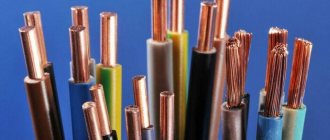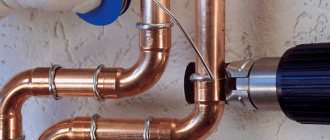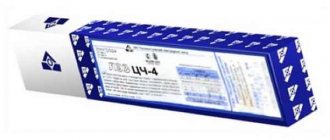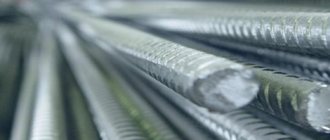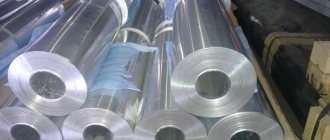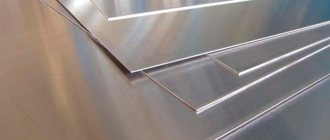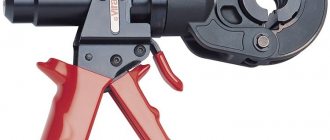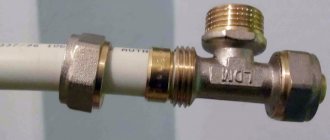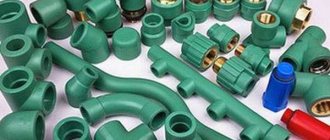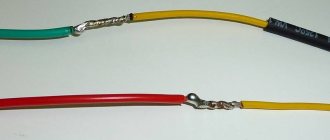When two dissimilar metals come into contact and an electrolyte such as moisture is present, there is a possibility of bimetallic corrosion on the more electronegative or anodic metal, as defined in the electrochemical series, which corrodes first, preventing the other metal from corroding.
The bimetallic effect is the basis for the protection that zinc coating (hot-dip galvanizing) provides to small areas of exposed steel if the coating is damaged. Zinc coatings corrode first, protecting the metal below it in the electrochemical series. The degree of bimetallic corrosion will depend on a number of factors such as the metals in contact, the ratio of the areas of the contacting metals and operating conditions. Generally, the level of bimetallic corrosion will increase as the potential difference between the two metals increases, such as how far apart the two metals are in the galvanic voltage series. However, the potential may vary due to the formation of the oxide layer and cannot be used to determine the extent of bimetallic corrosion, as other factors listed below are also important. The area ratio of the contacting metals is essential, and ideally the anode-cathode metal ratio should be high. If the ratio decreases, problems may arise due to high levels of oxygen reduction, which can lead to increased corrosion of the anode metal. The influencing conditions are of great importance, because For bimetallic corrosion, the electrolyte must bind the two metals present. As a result, in dry environments (indoors) the likelihood of bimetallic corrosion is very low, while in outdoor atmospheric conditions the likelihood increases due to the presence of moisture in the form of rain and condensation. The worst conditions are immersion in a solution where the electrolyte permanently bonds the two metals. Typically, any possibility of bimetallic corrosion can be mitigated by electrically isolating the two metals from each other. For bolted connections, connections can be achieved by using neoprene or plastic washers, while for overlapped surfaces this can be achieved by using plastic spacers or painting one of the surfaces with a suitable paint coating system. Generally, hot-dip galvanized steel performs well in contact with most common structural metals when exposed to atmospheric conditions, providing a high galvanized steel to other metal area ratio. Conversely, under immersion conditions the effect of bimetallic corrosion is greatly increased and insulation is usually required.
Copper and brass
If the installation requires contact between galvanized materials and copper or brass in a damp or humid environment, rapid corrosion of the zinc may occur. Even wastewater can contain enough dissolved copper to cause rapid corrosion.
If the use of copper or brass in contact with galvanized coatings is unavoidable, precautions must be taken to prevent electrical contact between the two metals. The connector surface must be insulated with non-conductive pads; connections must be made with insulating fasteners and a sealing sleeve. This is to ensure that the water does not re-spread and the flow of water from the galvanized surface to the copper or brass is not reversed.
Corrosion, gravel and noise
Those who follow our anti-corrosion publications are well aware of the drug Dinitrol 479. Once upon a time, the YuVK company and I called it “three in one”: it protects the underbody from corrosion, protects wheel arches from gravel, and reduces road noise in the cabin .
Then the slogan “Dinitrol 479 - three in one” became an Internet meme and was spread across many sites. As usual, without any reference to “ABS-auto” and YuVK. Let this remain on the conscience of the copy-pastors, especially since stealing is fashionable today, but they don’t know how to work.
So, “three in one”. In other words, Dinitrol 479 combines the functions of a classic anti-corrosion material for the bottom, anti-gravel coating and sound insulation. However, the manufacturer formulates its purpose differently: “soundproofing material with anti-corrosion and anti-gravel properties.”
But progress does not stand still. Today the famous 479th has an alternative solution - the drug Dinitrol 650 BD.
This composition is black, wear-resistant and durable. Created on the basis of bitumen, contains special fillers and a minimum of soft solvent, which is caused by environmental requirements. Therefore, the material is safe for health and does not harm the paintwork of the body, as well as plastic and rubber parts - everything here is the same as its predecessor Dinitrol 479.
And of course, Dinitrol 650 BD is not afraid of cold and heat - the temperature range in which the solid film retains its performance characteristics is from –25 to +90° C. And when applied, the material does not flow off a vertical surface due to thixotropy.
What is the difference, you ask? We have already seen all of the above in the 479th... But here’s what.
First. Dinitrol 650 BD can be applied to surfaces primed with Dinitrol ML liquid anticorrosive. Such priming is necessary when the bottom or arch is affected by corrosion. Dinitrol ML penetrates rust and stops the deterioration of steel thanks to its effective corrosion inhibitors.
So, the new composition Dinitrol 650 BD, applied 2-4 hours after the ML preparation, provides excellent adhesion to the metal. And it immediately puts its own inhibitors into action.
Second. The new material can be applied using professional equipment using an airless method. The pumps used are 26:1 or 65:1, 0.018 inch nozzle. The material can be applied in thick layers, and the optimal spray distance is approximately 30 cm.
The advantages of this method are obvious: economical consumption of the drug and cleanliness of the anti-corrosion area. After all, airborne spraying inevitably releases some of the material into the environment in the form of fog.
An example of processing the wheel arches of a Toyota Yaris 2007. On the left is an unprotected arch. The surface must be primed with a liquid anti-corrosion agent such as Dinitrol ML. And then apply a layer of Dinitrol 650 BD. The result is shown in the right photo
An example of processing the underbody of a Toyota Yaris 2007. Surfaces with traces of rust should be primed with a liquid anti-corrosion agent such as Dinitrol ML. And then apply a layer of Dinitrol 650 BD - just like in the case of the arches. The result is shown on the right
As a result, we get a durable film that protects against corrosion, flying road gravel and salt, and also reduces noise. Thus, the car becomes more comfortable, and traveling on it more enjoyable.
Let us conclude this chapter with a formal listing of the areas where Dinitrol 650 BD can be used. These are the chassis, underbody and wheel arches of passenger cars and commercial vehicles, as well as buses. These vehicles can be protected anytime and anywhere: during production, during operation and maintenance in fleets and service stations, in garages and private workshops.
And the manufacturer of Dinitrol 650 BD also indicates other industries - for example, shipbuilding. And although this is not our topic, it is still interesting - how will the new material perform in sea water? Probably won't let you down.
The simplest and most reliable connection between aluminum and copper wires
How to safely and correctly connect an aluminum conductor to copper and which adapter to use from one metal to another - on this matter, every electrical installation specialist has his own opinion, developed as a result of an analysis of work and personal experience. But most of them say that the simplest, most modern and safest method to connect copper and aluminum wiring is using WAGO terminal blocks with paste. They are safe for wires, and installation with them takes a minimum of time. In this case, the cheapest way is to use a bolt with a nut and washers to align the cables.
What methods to use to make the transition from aluminum to copper is up to everyone to decide for themselves.
Can stainless steel rust?
There are three groups of stainless steels, each of which has its own characteristics and specific application:
- Corrosion resistant steel. It has high resistance to corrosion in uncomplicated conditions - at home, at work.
- Heat-resistant steel. It is heat resistant, does not rust at elevated temperatures, and can be used in chemical plants.
- Heat-resistant steel. Remains mechanically strong at high temperatures.
Thus, not all types of stainless steel are intended for use in a particular aggressive environment. For example, using ordinary stainless steel in food production and frequent washing with chlorine-containing products will cause rapid deterioration of the material. Similarly, the use of metal in seawater will increase the corrosion rate significantly.
Also, rust often appears on stainless steel after welding (heat treatment), which was carried out without following certain rules. After mechanical damage to the metal, the consequences will be similar: pitting corrosion will occur at the site of the defect. Smooth, polished material usually rusts less intensely than rough material: on the latter, corrosion elements can appear much faster.
Protection against rust is violated where hot scale gets in, since a strong increase in temperature in non-heat-resistant steel causes alloying substances (mainly chromium) to burn out. After holes burn through, their edges and adjacent areas become susceptible to corrosion, although deeper layers of metal most often remain intact. Treatment with etching pastes and special emulsions will help save stainless steel.
Other causes of stainless steel corrosion:
- contact of the material with ordinary carbon steel (including through tools that used to cut ordinary steel);
- regular cleaning with metal brushes;
- ignoring mechanical or chemical treatment of the weld.
The cause of metal corrosion can also be its initially low quality. The resistance of steel to rust is due to the presence of chromium in sufficient quantities. This element, after exposure to water, air, acids and alkalis, forms a thin impenetrable layer that prevents the material from rusting. If there is little chromium in the composition or it is unevenly distributed, the creation and maintenance of an oxide layer becomes impossible.
Save aluminum
Modern automotive industry is unthinkable without the use of aluminum materials. In what follows, we will use the term “aluminum” to mean not pure metal, but structural alloys based on it.
The first Land Rovers had aluminum bodies, and many Defenders with a steel frame and aluminum panels still roam the roads around the world. Many models of Audi, Jaguar, Volvo, BMW, Mazda pickups and other cars have aluminum parts. And of course, engine cooling and air conditioning systems without aluminum are unthinkable.
“Aluminum does not rust” - we remember this phrase from school. We were also told that in air, products made of aluminum alloys are spontaneously covered with a thin oxide film of Al2O3 - this is what protects them from further corrosion attacks. That's why housewives have been using aluminum cookware for decades.
Aviation materials for the protection of aluminum parts, prototypes Dinitrol 713 IQ
That's right. But in mechanical engineering the picture is much more complicated. Vibrations, temperature changes, humid and chemically aggressive environments (remember, for example, salt solutions on the roads) - these and other factors damage the “natural” protective film and prevent its restoration.
At the points of contact of the aluminum alloy with steel (and in most structures this is inevitable), galvanic couples arise. Since aluminum is a more active metal than iron, electrochemical corrosion eats away at it. So an aluminum tube with a steel fitting is not such a harmless thing. Galvanic couples are also formed in the areas of welds. And after electrochemical corrosion comes intergranular corrosion, which destroys the grain boundaries of the metal.
Dinitrol 713 IQ creates a lightweight transparent film with a thickness of only 15 microns, which perfectly transmits heat without reducing the efficiency of the heat exchanger
The main danger of intergranular corrosion is that it significantly reduces the strength and other mechanical characteristics of the product while maintaining an unchanged appearance. And if you load the part a little more, it will crumble into powder.
Unfortunately, in this case, practice confirms the theory. Every year, dealer services replace many heat exchangers made of “winged metal”.
Preparations for the protection of aircraft alloys are marked with the AV index, for example, AV‑15. In Sweden they were used for anti-corrosion protection of radiators of Mercedes cars. This is how the purely aviation personnel acquired automotive experience. The protection turned out to be so effective that based on AV-15, the drug Dinitrol 713 IQ was created - a special anticorrosive agent for automotive components and parts made of aluminum. However, he knows how to protect copper, bronze, brass, and stainless steel, which in fact also does not last forever.
“Seven hundred and thirteenth” adopted all the advantages of the “flying brother” AV‑15, namely:
– a unique ability to preserve aluminum alloys (aviation!), which is achieved through special inhibitors;
– create a very light (aviation again!) and thin transparent film on the surface – its thickness is only 15 microns, and, by the way, it perfectly transmits heat without reducing the efficiency of the protected heat exchanger;
– technologically advanced application (again, aviation!).
Speaking of manufacturability, we emphasize that Dinitrol 713 IQ material is a so-called one-step material that does not require preliminary priming. He is “his own director”: he penetrates into all the cracks and other hard-to-reach areas of the structure and ensures his own adhesion. Apply with a brush, spray gun or dip.
If it is necessary to repair the air conditioning system, the Dinitrol 713 IQ film is washed off with hot water under pressure - a regular washing machine is sufficient for this. And when operating a car, it is recommended to regularly update the protective film, for example, before each winter.
Now it’s up to the service station technicians to speak. If they arm themselves with Dinitrol 713 IQ, the number of air conditioner breakdowns will decrease. And people will quickly realize that it is better to pay for treatment than to change expensive air conditioner components.
Proper Methods for Safe Connections in Electrical Wiring
Since the chemical properties of copper and aluminum are significantly different, standard techniques are not suitable for combining them. There is an opinion that it is generally not worth connecting these types of wires. Yes, standard twisting is categorically unacceptable here, but other methods that do not allow contact of conductors, but allow the full integration of copper and aluminum wiring, are perfect.
Bolted connection via bolt and steel washers
A method with a high degree of reliability is a bolted connection, which even a non-professional can do. In this case, direct contact, which is undesirable for copper with aluminum, is completely eliminated; conductors of different sections can be combined.
To connect aluminum and copper wires to each other in this way, you will need:
- Bolt;
- Screw;
- Steel washers;
- Wrench.
It is worth understanding that a knot made in this way will turn out to be quite cumbersome, which makes the method not always convenient. It is unlikely to be acceptable in a small apartment junction box, but it is perfect for a general electrical panel where there is enough space.
How to connect aluminum wires to copper using the bolt method:
1. Remove the insulation layer from the cables being connected;
2. Shape the stripped ends into the shape of a ring;
3. Install a washer, a ring of the first wire, a washer, a ring of the second, a washer, a nut, tightened until it stops;
4. Apply insulation with tape.
Important! The washer must separate the aluminum and copper wires. When installing conductors of the same material, a washer is not needed.
Terminal adapters and terminal blocks
Another solution for how to properly connect copper and aluminum wires is the use of terminals and terminal blocks. They consist of a transparent plastic housing with cells and clamping screws, inside of which a brass sleeve is placed. With one block you can connect a different number of pairs of conductors by selecting the required number of cells.
How to use terminal blocks to connect wires:
1. Unscrew the clamp screw;
2. Remove the insulating layer from the conductor;
3. Insert the cable into the terminal and tighten the clamping screw.
The same is done by fastening the cable on each side.
Important! When fixing with a clamping screw, it is important not to overdo it, since excessive force can damage the core.
WAGO terminal blocks for aluminum and copper with paste inside (or without paste)
Terminals from the German brand WAGO are well known to electricians and enjoy a high level of trust. For cables made of one material, the company produces terminal models with flat spring clamps and equipped with clamping levers. To connect aluminum and copper, WAGO offers a variety of 2273 series terminals with contact paste inside.
Since the characteristics of copper and aluminum are different, direct contact between them is prohibited. To eliminate this, contact paste is needed inside the terminals.
Important! Before connecting copper and aluminum conductors using WAGO terminals, the paste from the copper socket must be thoroughly cleaned.
It happens that terminal blocks are sold without paste. In this case, such WAGO conductive paste for aluminum can always be purchased separately; it is called WAGO “ALU-PLUS” art. 249-130
Method of crimping sleeves using press pliers: sleeves
Connecting wires by crimping with sleeves is a costly process, but it allows you to obtain a durable result, as well as reliable contact. You will need special sleeves that look like hollow tubes that act as a connector. Press pliers are also needed, which can be manual or mechanical.
The connection of copper and aluminum wires by crimping is carried out using combined sleeves. They are marked GMA, called aluminum-copper, and are designed for operating voltages up to 10 kV. Consumers are offered options available for different core cross-section sizes - 16/10, 25/16, 35/25, 50/35, 70/50, 95/70, 120/95, 150/120, 185/150, 240/185.
To perform the work:
1. The insulating layer is removed at the ends of the cable;
2. Conductors are placed on those parts of the sleeves that are made of the same metal;
3. The sleeve is crimped using press pliers in several places, then insulated using tape.
Important! To carry out crimping, only special press pliers are used. Using a hammer or pliers for these purposes can damage the sleeve.
Riveted
One-piece methods for connecting electrical wires include the use of rivets.
Riveter; Rivet; Steel washer. How to connect conductors using the rivet method:
1. Remove the insulation layer from the ends of the cables;
2. Rings of conductors will be formed according to the same principle as with the bolt method;
3. A conductor ring, a washer, and a second conductor ring are put on the rivet;
4. The rivet is placed in the rivet gun and compressed;
5. The contact point between aluminum and copper is insulated.
The one-piece method is very reliable, but has a drawback - the unit cannot be disassembled without damaging it.
Walnut type clamps
You can connect copper and aluminum wires using a branch clamp, which many call a “nut” or “nut”. It consists of a polycarbonate body with a metal core. Inside it are two dies with grooves for a certain cross-section, between which the plates are located. The structures are held together with bolts.
To connect a copper wire to an aluminum branch clamp you need:
- Disassemble the compression housing;
- Remove the insulation on the cables being connected;
- Loosen or completely remove the fixing bolts, place the conductors in the grooves;
- Tighten the fasteners;
- Close the compression housing.
Installation is quick and easy to understand even for a beginner. The main disadvantage of the method is the lack of tightness. Water and dirt may get inside the housing. You can avoid this by using regular electrical tape.
Connecting wires to the machine
There is a lot of debate about whether it is possible to connect aluminum wires with copper wires in a machine. Simply inserting two conductors and securing them in the machine is a mistake that will lead to oxidation and then burnout of the cable.
A solution is to tin the copper conductor. The procedure is simple, but it is not always possible to perform it. The reliability of the method is average.
The second solution is to insulate the aluminum using a piece of tin from a can lid. To do this, a small strip of tin is cut out, which needs to be wrapped around the end of the conductor. For reliable contact, crimping is done with pliers, the excess is cut off, and the place where the sheet is attached is carefully crimped again, but without much effort.
Afterwards, you can safely secure the cables in the machine without fear of their contact.
How to connect SIP and copper wire: features of each option
Depending on the location of the metering board, the SIP connection options may vary.
If the metering board is located on a line support, the connection is made through a solid conductor. Within the shield, it is directly connected to the machine. To connect conductors to the line, it is recommended to use a standard piercing clamp, which is specially designed for SIP lines.
On a note! Piercing clamps are designed to connect taps to the main line. Such specimens can be used to connect lines whose cross-section ranges from 16 to 120 mm2, and the tap cross-section ranges from 6 to 50 mm2. In this case, both SIP and a standard cable made of copper can serve as a tap.
The main compression elements are two plates with sharp teeth made of steel. When the mounting bolts are tightened, they come closer to each other and, at the moment of piercing the wire insulation, they create reliable contact and sealing of the fastening point. The bolts are tightened until they break, which is designed for a certain compressive force. Moreover, the design is disposable.
If it is decided to make the connection from the metering panel to the house using self-supporting insulated wires, then standard fittings are also indispensable. The best option would be to run the wire into the distribution box and connect it to the circuit breaker in the switchboard. In such a case, there is no need to connect it to the cable.
On a note! To connect SIP with bare (uninsulated) wires, a special clamp should be used. It should have no sharp teeth on the side where the bare wire is attached.
If the metering board is placed on the wall of the house, the tap, which is connected to the main line by means of a clamp, is inserted into the metering board and connected to the machine. If the role of the sealing conductor is performed by the SIP, so-called anchor clamps are mounted on the support line and on the wall, providing fastening of the wires.
Source
How to connect an aluminum wire to a copper wire on the street: key features of the process
During the installation of cable lines in outdoor conditions, each of the connecting elements is exposed to the influence of negative environmental factors. Snow, rain, fog, and icing will definitely not contribute to high quality connections.
In this regard, to carry out such work, an exclusively sealed structure will be required. Moreover, it must be characterized by resistance to low temperatures and ultraviolet rays.
If you decide to make the connection outdoors, you should arm yourself with the knowledge of how to connect a SIP cable to a copper wire. After all, it is through this operation that you can connect copper and aluminum wires in open areas.
